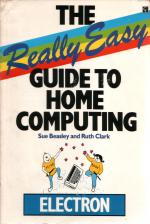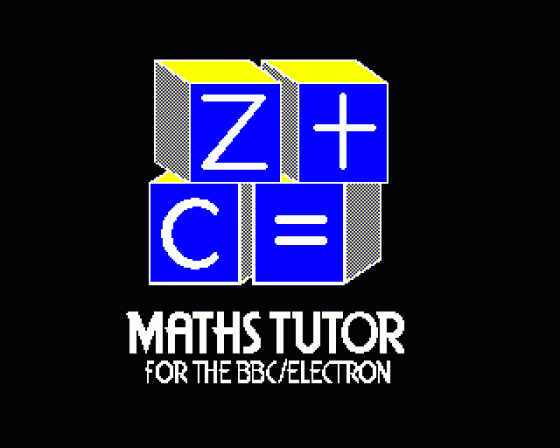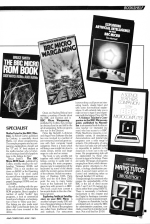More good reads from the BBC/Electron library
Bookshelf
Two main categories of masterpieces in print for our 6502 machines this month...
Getting Started
For newcomers to the Electron, two contrasting releases. Century's The Really Easy Guide To Home Computing is an Electron version of a general introduction for younger children. It's 250 pages of super design, small programming examples mixed in with a multitude of humorous drawings.
The clear layout, unambiguous descriptions and inspirational illustrations mean that this book will keep kids at the computer keyboard, keep them interested and teach them a thing or two into the bargain. The authors have highly qualified backgrounds in teaching new subjects to the younger age group, and it shows. It's a large format book and fair value at £7.95.
Programming the ELECTRON published by Newnes Microcomputer Books, is an overall introduction to programming specific to Electron BASIC and Assembler. A handy size for the train, or bus, 150 pages manages to pack in all the information you are likely to need in the first months of programming your machine.
For the BBC, Ian Graham's Step-By-Step Programming For The BBC Micro, published by Dorling-Kindersley, is a colourful, almost magazine style, introduction to BBC BASIC programming.
Programs, and their results are displayed, photographed on-screen, alongside a brief explanation. A very attractive book indeed but without the in-depth coverage of programming we have come to expect from computer books. A welcome change at £5.95. Getting Started In Sound And Graphics On The BBC Micro from Database Publications is a super introduction to these two most popular of programming subjects.
Ideal for the newcomer to the computer, a straightforward style and plenty of examples mean that the user can work through the book at his own pace. £5.95 but packed with information.
Specialist
Maths Tutor For The BBC/Electron by Robert Carter, published by Century, is essentially about Maths, not about programming. The sample programs and accompanying explanations should suit the "O" and "A" level student or the maths teacher, who is fortunate in having a class full of pupils to type in the listings for him!
Bruce Smith's The BBC Micro ROM Book, published by Collins, sensibly employs the sub-heading "Sideways KOMs and RAMs". This is not another rundown on BASIC or the Operating System but a far more useful account of how to implement your own sideways ROM software, paged (language) ROMs and service ROMs.
As well as dealing with the protocols employed in implementing ROM programs, Bruce supplies a number of useful "toolkit" type programs, a look at commercial boards and software, and explanation of how to "Blow your own". The listings are also made available in Bar Code Reader form, for those who have invested in this device. Owen and Audrey Bishop have written a number of books about the BBC and Electron and in BBC Micro Wargaming, published by Collins, they indulge an obvious love for and skill in the art of wargaming. All the programs also run on the Electron.
Firms like Redshift, Lothlorien and Argus Press Software (the last two now involved in a number of joint ventures), have had great success with their computer-based wargames. Here is a book which will bring a new insight into how to create armies, terrain and larger maps in code and on screen.
The book is very sensibly put together with initial introductory listings coming in useful later in constructing the main programs. Anyone new to wargaming will be fascinated by some of the details which the modern games demand of the software. Actual reconstructions of Hastings 1066, Paris 1814, and the sci-fi Bena 2352 point the way to many happy hours at the keyboard for wargame fans with access to a BBC. This book could even convert a few arcade freaks to the role of tactician/general.
Exploring Artificial Intelligence On Your BBC Micro is another bumper (nearly 300) edition of program listings on the periphery of AI. Most of the programs are culled from traditional ideas and methods. For newcomers however they could prove an interesting bunch, clearly listed and with some hon-technical explanations. It will certainly take you a night or two to type in and experiment with the listings. Price: £6.95.
A Science Teacher's Companion To The BBC Microcomputer
A Science Teacher's Companion To The BBC Microcomputer, published by Macmillan is an essential book for the science teacher (or interested layman) who has access to a BBC. Philip Hawthorne presents a considerable variety of simulations, demonstrations and tutorial type programs over a wide range of subjects. His philosophy of using the micro for tasks not well suited or impossible to perform in the classroom is born out in the software. His programming style will be appreciated by those who choose to type in the listings. There are nearly 100 pages of programs ranging from Atom, which demonstrates atomic structures to Animals, a biology classification program.
A second major section on control and interfacing takes us through familiar I/O territory. Disappointingly for someone who praises the upgradeability of the BBC is the use of direct access (with ? and !) to I/O memory locations rather than using OSBYTE. There is necessarily a hardware involvement in this chapter and the Digital to Analogue converter could prove a very popular project. Chapters on Assembler, for the uninitiated and on using the BBC for administrative purposes, conclude a must for its intended audience. Not at all bad for £9.50.
This article was converted to a web page from the following pages of A&B Computing 2.06.


 1st June 1985
1st June 1985



